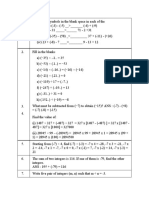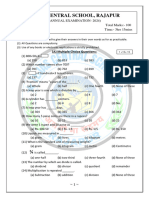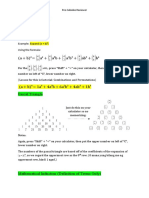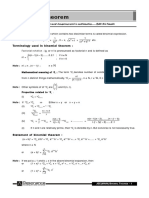0 ratings0% found this document useful (0 votes)
7th Mathematics 1,2,3
7th Mathematics 1,2,3
Uploaded by
Khamalesh C.AThis document contains a math test with multiple choice and fill-in-the-blank questions covering topics like operations with integers, algebraic expressions, properties of parallelograms and rhombi. There are 29 multiple choice questions and 20 fill-in-the-blank questions testing skills with integers, expressions, equations and properties of 2D shapes.
Copyright:
© All Rights Reserved
Available Formats
Download as DOCX, PDF, TXT or read online from Scribd
Download as docx, pdf, or txt
7th Mathematics 1,2,3
7th Mathematics 1,2,3
Uploaded by
Khamalesh C.A0 ratings0% found this document useful (0 votes)
This document contains a math test with multiple choice and fill-in-the-blank questions covering topics like operations with integers, algebraic expressions, properties of parallelograms and rhombi. There are 29 multiple choice questions and 20 fill-in-the-blank questions testing skills with integers, expressions, equations and properties of 2D shapes.
Copyright
© © All Rights Reserved
Available Formats
DOCX, PDF, TXT or read online from Scribd
Share this document
Did you find this document useful?
Is this content inappropriate?
This document contains a math test with multiple choice and fill-in-the-blank questions covering topics like operations with integers, algebraic expressions, properties of parallelograms and rhombi. There are 29 multiple choice questions and 20 fill-in-the-blank questions testing skills with integers, expressions, equations and properties of 2D shapes.
Copyright:
© All Rights Reserved
Available Formats
Download as DOCX, PDF, TXT or read online from Scribd
Download as docx, pdf, or txt
0 ratings0% found this document useful (0 votes)
7th Mathematics 1,2,3
7th Mathematics 1,2,3
Uploaded by
Khamalesh C.AThis document contains a math test with multiple choice and fill-in-the-blank questions covering topics like operations with integers, algebraic expressions, properties of parallelograms and rhombi. There are 29 multiple choice questions and 20 fill-in-the-blank questions testing skills with integers, expressions, equations and properties of 2D shapes.
Copyright:
© All Rights Reserved
Available Formats
Download as DOCX, PDF, TXT or read online from Scribd
Download as docx, pdf, or txt
You are on page 1/ 3
7th one marks test
Chapter-1,2,3 (1x75=75)
Fill in the blanks:
(1) (-30) + ____ = 60 (2). (-5) + ___ = -100 (3.) (-52) + (-52) = ____ (4.) ____ + (-22) = 0
(5.) ____ + (-70) = 70 (6.) -44 + ____ = -88 (7.) ___ – 75 = -45 (8.) ___ – (+50) = -80
(9.) 20 + 80 + ___ = 0 (10.) (-40) ÷ ___ =40 11.) -80 × ____ = -80 12.) 25 ÷ ____ = -5
13.)An expressions equated to another expression is called _______.
(14) If a = 5, the value of 2a + 5 is _______.
(15) The sum of twice and four times of the variable x is ______.
(16) 75 + (-25) = ____ (17). 171 + ___ = 0 (18.) (-10) × ____ = 20
(19.) [(-3) + (-12)] + (-77) = _____ + [(12) + (-77)]
(20) (-42) + [____ + (-23)] = [____ + 15] + ____
(21.) ____ ÷ (-4) = 9 (22.) (-62) ÷ (-62) = ____ (23). 100 × ___ = -500
(24.) ____ × (-9) = -45 (25) ___ × 75 = 0
26.) The addition of – 7b and 2b is _______
(27) The subtraction of 5m from -3m is ______
(28.) The additive inverse of -37xyz is _____
Say True or False.
(29) The additive inverse of (-32) is -32
(30) The expressions 8x + 3y and 7x + 2y cannot be added
(31) Every algebraic expression is an equation.
(32) The expression 7x + 1 cannot be reduced without knowing the value of x.
(33) To add two like terms, its coefficients can be added.
(34) If x is a natural number, then x + 1 is its predecessor
(35) (-90) + (-30) = 60
(36) (-125) + 25 = -100
(37.) (-30) ÷ (-6) = -6
(38) (-64) ÷ (-64) is 0
(39) (-675) – (-400) = -1075
(40) 15 – (-18) is the same as 15 + 18
(41) (-45) – (-8) = (-8) – (-45)
Objective questions
1.Identify the problem with negative numbers as its answer.
(i) -9 +(-5) + 6 (ii) 8 + (-12) – 6 (iii) -4 + 2 + 10 (iv) 10 + (-4) + 8
2.(-10) + (+7) = ____
(i) +3 (ii) -3 (iii) -17 (iv) +17
3.20 + (-9) + 9 = ____
(i) 20 (ii) 29 (iii) 11 (iv) 38
4. (-8) + 10 + (-2) = ____
(i) 2 (ii) 8 (iii) 0 (iv) 20
5.(-100) – 0 + 100 =
(i) 200 (ii) 0 (iii) 100 (iv)-200
6.(-5) – (-18)
(i) 23 (ii) -13 (iii) 13 (iv) -23
7.Which of the following expressions is equal to -30.
(i) -20 – (-5 × 2) (ii) (6 × 10) – (6× 5) (iii) (2 × 5)+ (4 × 5) (iv) (-6) × (+5)
8.Which property is illustrated by the equation: (5 × 2) + (5 × 5) = 5 × (2 + 5)
(i) commutative (ii) closure (iii) distributive (iv) associative
9. Question 10.
11 × (-1) = _____
(i) -1 (ii) 0 (iii) +1 (iv) -11
10. Which of the following does not represent an integer?
(i) 0 ÷ (-7) (ii) 20 ÷ (-4) (iii) (-9) ÷ 3 (iv) 12 ÷ 5
11. (-16) ÷ 4 is the same as
(i) -(-16 ÷ -4) (ii) -(16) ÷ (-4) (iii) 16 ÷ (-4) (iv) -4 ÷ -16
12. (-200) ÷ 10 is
(i) 20 (ii) -20 (iii) -190 (iv) 210
13. The set of integers is not closed under
(i) Addition (ii) Subtraction (iii) Multiplication (iv) Division
14.The perimeter of a parallelogram whose adjacent sides are 6 cm and 5 cm is
(i) 12 cm (ii) 10 cm (iii) 24 cm (iv) 22 cm
15. The area of parallelogram whose base 10 m and height 7 m is
(i) 70 sq.m (ii) 35 sq.m (iii) 7 sq.m (iv) 10 sq.m
16. The base of the parallelogram with area is 52 sq. cm and height 4 cm is
(i) 48 cm (ii) 104 cm (iii) 13 cm (iv) 26 cm
17.What happens to the area of the parallelogram if the base is increased 2 times and the
height is halved?
(i) Decreases to half (ii) Remains the same (iii) Increase by two times (iv) None
18.In a parallelogram the base is three times its height. If the height is 8 cm then the area is
(i) 64 sq. cm (ii) 192 sq. cm (iii) 32 sq. cm (iv) 72 sq. cm
19. The area of the rhombus with side 4 cm and height 3 cm is
(i) 7 sq. cm (ii) 24 sq. cm (iii) 12 sq. cm (iv) 10 sq. cm
20. The area of the rhombus when both diagonals measuring 8 cm is
(i) 64 sq. cm (ii) 32 sq. cm (iii) 30 sq. cm (iv) 16 sq. cm
21.The area of the rhombus is 128 sq. cm. and the length of one diagonal is 32 cm. The
length of the other diagonal is
(i) 12 cm (ii) 8 cm (iii) 4 cm (iv) 20 cm
22. The height of the rhombus whose area 96 sq. m and side 24 m is
(i) 8 m (ii) 10 m (iii) 2 m (iv) 4 m
23. The angle between the diagonals of a rhombus is
(i) 120° (ii) 180° (iii) 90° (iv) 100°
24. The addition of 3mn, -5mn, 8mn and – 4mn is
(i) mn (ii) – mn (iii) 2mn (iv) 3mn
25. When we subtract ‘a’ from ‘-a’, we get ______
(i) a (ii) 2a (iii) -2a (iv) –a
26.In an expression, we can add or subtract only _____
(i) like terms (ii) unlike terms (iii) all terms (iv) None of the above
27. The generalization of the number pattern 3, 6, 9, 12, …………. is
(i) n (ii) 2n (iii) 3n (iv) 4n
28. The solution of 3x + 5 = x + 9 is t
(i) 2 (ii) 3 (iii) 5 (iv)4
29. The equation y + 1 = 0 is true only when y is
(i) 0 (ii) -1 (iii) 1 (iv) – 2
You might also like
- Stained Glass Window: Linear Equation Worksheet0% (1)Stained Glass Window: Linear Equation Worksheet2 pages
- MMAE 517: Illinois Institute of TechnologyNo ratings yetMMAE 517: Illinois Institute of Technology227 pages
- 7th Class Math Cbse (Ncert) Chapter Integer Important QuestionsNo ratings yet7th Class Math Cbse (Ncert) Chapter Integer Important Questions2 pages
- Mathematics Form 1 Chapter 1 Rational NumbersNo ratings yetMathematics Form 1 Chapter 1 Rational Numbers31 pages
- integers, Std 7 R.S.Aggarwal MathematicsNo ratings yetintegers, Std 7 R.S.Aggarwal Mathematics2 pages
- Class Ii (Mathematics) Tejas Question Paper 2024No ratings yetClass Ii (Mathematics) Tejas Question Paper 20244 pages
- Worksheet Class:Vii Mathematics Chapter 1: INTEGERS Fill IN THE BlanksNo ratings yetWorksheet Class:Vii Mathematics Chapter 1: INTEGERS Fill IN THE Blanks4 pages
- CBSE NCERT Solutions For Class 8 Mathematics Chapter 6: Back of Chapter QuestionsNo ratings yetCBSE NCERT Solutions For Class 8 Mathematics Chapter 6: Back of Chapter Questions32 pages
- NCERT Solutions For CBSE Class 8 Maths Chapter 9 Algebraic Expressions and Identities Exercise 9.5No ratings yetNCERT Solutions For CBSE Class 8 Maths Chapter 9 Algebraic Expressions and Identities Exercise 9.58 pages
- Negative Numbers and Integers: Class VI. Maths Worksheet100% (1)Negative Numbers and Integers: Class VI. Maths Worksheet4 pages
- CBSE Sample Papers For Class 3 Maths With Solutions - Mock Paper 1No ratings yetCBSE Sample Papers For Class 3 Maths With Solutions - Mock Paper 18 pages
- CBSE Sample Papers For Class 3 Maths With Solutions - Mock Paper 1No ratings yetCBSE Sample Papers For Class 3 Maths With Solutions - Mock Paper 18 pages
- CBSE Sample Papers for Class 3 Maths With Solutions - Mock Paper 1No ratings yetCBSE Sample Papers for Class 3 Maths With Solutions - Mock Paper 18 pages
- Selina Sol Concise Maths Class 7 Ch1 IntegersNo ratings yetSelina Sol Concise Maths Class 7 Ch1 Integers23 pages
- Exercise 5.3 (Solutions) : Merging Man and MathsNo ratings yetExercise 5.3 (Solutions) : Merging Man and Maths6 pages
- RS Aggarwal Solutions Class 7 Chapter-1 Exercise 1.1No ratings yetRS Aggarwal Solutions Class 7 Chapter-1 Exercise 1.114 pages
- NCERT Solutions for Class 7 Maths Chapter 13No ratings yetNCERT Solutions for Class 7 Maths Chapter 1310 pages
- NCERT Class 10 Maths Answers and Solutions PDFNo ratings yetNCERT Class 10 Maths Answers and Solutions PDF20 pages
- Holiday Assignment Mathematics - Grade 6No ratings yetHoliday Assignment Mathematics - Grade 68 pages
- Pertran - A Transport-Perturbation ProgramNo ratings yetPertran - A Transport-Perturbation Program67 pages
- Piecewise and Inverse Functions and Composition of Functions50% (2)Piecewise and Inverse Functions and Composition of Functions35 pages
- Star English Boarding School Bagtar, Colony First Terminal Examination 2076No ratings yetStar English Boarding School Bagtar, Colony First Terminal Examination 20763 pages
- Cohomology and Versal Deformations of Hom-Leibniz AlgebrasNo ratings yetCohomology and Versal Deformations of Hom-Leibniz Algebras22 pages
- (Ebooks PDF) Download A First Course in Topology John Mccleary Full Chapters100% (2)(Ebooks PDF) Download A First Course in Topology John Mccleary Full Chapters60 pages
- Non-Attacking Queens On A Triangle: Gabriel Nivasch Eyal LevNo ratings yetNon-Attacking Queens On A Triangle: Gabriel Nivasch Eyal Lev6 pages
- Chapter One 1.1. Theoretical Versus Mathematical Economics Example. ExampleNo ratings yetChapter One 1.1. Theoretical Versus Mathematical Economics Example. Example19 pages
- Business Mathematics Set - B SECTION - A Answer ALL The Questions 10 X 2 20 MarksNo ratings yetBusiness Mathematics Set - B SECTION - A Answer ALL The Questions 10 X 2 20 Marks6 pages
- ISC - 2019 Paper-7: 2, Find A 3 Tan 1 3 (X, Y) : x+2 y 8No ratings yetISC - 2019 Paper-7: 2, Find A 3 Tan 1 3 (X, Y) : x+2 y 83 pages
- 1.1 Trig Ratios in Right Triangles Part 1No ratings yet1.1 Trig Ratios in Right Triangles Part 15 pages
- Solid State Physics 2 Edition/ Giuseppe Grosso: Geometrical Description of Crystals:Direct and Reciprocal LatticesNo ratings yetSolid State Physics 2 Edition/ Giuseppe Grosso: Geometrical Description of Crystals:Direct and Reciprocal Lattices32 pages

























































































